How to Date Photographs by Fashion
The Costume Detective How to Date Photos with Costume History
- Using Costume History to Engagement an Old Photograph
- Fashion-era Photo Assay
- My Reply to Norman Estimating the Appointment of the Onetime Photograph
- Look for the Most Fashionable Details
- Hats
- Edwardian Hat Assay
- The Possible Date of the Photograph
- Norman'southward Response to my Dating the Photograph Deduction
- Sir Humphrey Davey
- Send Edifice Grand in Hebburn
Using Costume History to Date an Old Photograph
Fashion-era Photo Analysis
Fashion History Photo of Former Hebburn vi Miles from Newcastle Upon Tyne
The photograph shown here is an example of a crowd scene at the plough of the 20th century. It'due south a wonderful moving-picture show and I am showing it here to enable you lot readers to see how to analyse your own motion-picture show. My technique of using the costume as the main point of reference, may assist yous to appointment your own picture to inside five years.
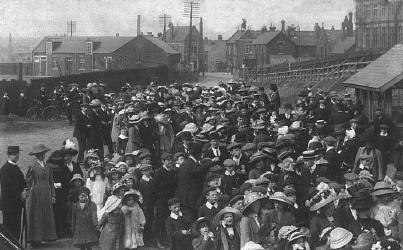 In this example I believe that I have dated this photograph to within 1 yr. To do this can exist something of a tall gild, because a photograph such as this might accept several days of thinking fourth dimension. So after I have mulled over it, several hours of bodily shut written report of the detail. This film of old Hebburn was kindly sent to me past Norman Dunn who has a website of quondam photographs he has been collecting for many years.
In this example I believe that I have dated this photograph to within 1 yr. To do this can exist something of a tall gild, because a photograph such as this might accept several days of thinking fourth dimension. So after I have mulled over it, several hours of bodily shut written report of the detail. This film of old Hebburn was kindly sent to me past Norman Dunn who has a website of quondam photographs he has been collecting for many years.
Right - Vintage Edwardian Photograph of Quondam Hebburn 6 miles from Newcastle upon Tyne.
All pictures enlarge on this folio and this motion picture is superb when enlarged. For an even larger/closer view, click beneath here on this tiny thumbnail and come across the original picture scan.

My Answer to Norman Estimating a Date of the Old Photo
This is the text I wrote to Norman:- I've been studying this photo now for some hours, because it really does interest me in getting the date right. Even at offset glance, it is clear that this picture is a superb representation of Edwardian middle class folk, with some working grade folk; the key signal is that all the people are dressed in the fashions of the solar day. The scene suggests they are either waiting for someone special to visit, such as the King or Queen, alternatively, that they are pending with serious intent for bad news of some accident, such every bit a mining or manufactory disaster. Another possibility is that they are awaiting send to take them on a trip for the day. If the twelvemonth was slightly later I might think they were seeing men off to war. Another point to be aware of is that at least some of the crowd may old fashioned, and behind the times in their dress. I'd say the photograph was taken in Spring as they all wear coats, simply also stylish Spring-similar hats, which could be Easter Bonnets for Mothering Sun.
Expect for the Almost Fashionable Details
Dress, Hair and Hairstyles
When dating a costume picture past wearing apparel, I always seek out the most fashionable details, which are more often than not found on the younger women. These details refer not simply to the garments themselves, but also the hairstyle, particularly hair partings and whether the hair fringes or sweeps up. Another source of clues are the hats, examine their width, tiptop and snugness of fit.
Hats
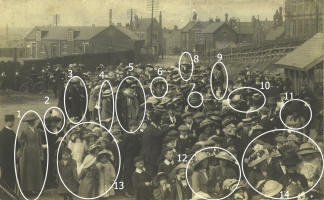 This photo has no hairstyles to concentrate on, but it does accept wonderful hats by the dozen. The fashion hats are the main clue here, as no heads are visible in the adult women. These hats are broad enough to be circa 1908-9, but could exist equally early as 1902 bearing in mind some of the clothes. Even with magnification I cannot notice one unmarried woman without a chapeau or head covering.
This photo has no hairstyles to concentrate on, but it does accept wonderful hats by the dozen. The fashion hats are the main clue here, as no heads are visible in the adult women. These hats are broad enough to be circa 1908-9, but could exist equally early as 1902 bearing in mind some of the clothes. Even with magnification I cannot notice one unmarried woman without a chapeau or head covering.
This picture is living proof that the era was even so dominated by formality, fifty-fifty the ordinary people obey the rules of etiquette as you tin see in the photography. That formality was swept away past the First World State of war when rigid rules of dress codes were broken downwardly. And this point helps us to date a photo equally the early on part of the twentieth century. I've circled a re-create of the original photograph as the particular is crisper and some circles will be used here to identify sure aspects of costume history details.
The Circled Sections in the Picture of the Old Hebburn Oversupply Scene
Several factors amongst the images suggest that nosotros should date the photograph later on 1895, upwards to the later dates of 1912. I don't feel this photograph is later than 1912, fifty-fifty in an unfashionable town. The boys with bicycles in the left hand side groundwork are wearing Eton fashion schoolhouse-compatible jackets, and collars often featured in books circa 1895. The puffed heads on garment sleeves are very subdued so that dates the picture later than 1895.
§
Edwardian Hat Analysis
Other than where specified, I am in all cases referring to female adult fashionable clothes. I can eliminate 1904 equally a possible date as there simply is non enough fullness in the sleeves of any of these adult garments, moreover, the children's dress supports this view. I believe information technology is after 1904 and the factor that suggests this most is the rounded domes of the hats. Yous can see what I mean by looking at the many instances of hats, as in circles vi, viii and 12. Click thumbnail for a full enlargement. These detailed circled sections are beside the explanatory text.
Ref. 6  Ref.8
Ref.8  Ref.12
Ref.12 
Let'due south look at the motion picture starting with circle 1. Elements of the coat could propose it to exist circa 1898. The sleeves with soft fullness at the caput and the fitted silhouette suggest belatedly Victorian styling. Merely the hat is also large for that date. Hats tight and neater, with less width, were dominant in the belatedly 1890s.
 Reference circumvolve 1 left, is probably one of the best sections to use for generally dating the picture. The moving-picture show below for reference 1 enlarges fully.
Reference circumvolve 1 left, is probably one of the best sections to use for generally dating the picture. The moving-picture show below for reference 1 enlarges fully.  The glaze is typically Edwardian, and considering a waist is in evidence, I think it is before 1910. After that appointment waistlines were much higher following Directoire styles, and under-the-bosom empire lines, but of course when women purchase a coat they even now expect two or 3 years wear from it. In those days they may have hoped for even longer wear.
The glaze is typically Edwardian, and considering a waist is in evidence, I think it is before 1910. After that appointment waistlines were much higher following Directoire styles, and under-the-bosom empire lines, but of course when women purchase a coat they even now expect two or 3 years wear from it. In those days they may have hoped for even longer wear.
The silhouette back of the glaze in circle 9 shown correct, is very straight indicating no swing-back sway, which was created by the S-bend style of 1900-1906.
Ref.3  Ref.iv
Ref.iv  Ref.5
Ref.5  Ref.xi
Ref.xi 
Reference circumvolve 5 above centre shows a typical tailor made adjust circa 1907-8. The necklines and tailoring of refernce circles ane, 3, 4, 6, and eleven could all be every bit late as 1912.

 Hats in reference circles 2 and 10 right evidence veiling which may be mourning veiling or motoring veiling.
Hats in reference circles 2 and 10 right evidence veiling which may be mourning veiling or motoring veiling.
1907-8 saw the kickoff of a new body silhouette called the Empire, or Directoire, where the long columnar outline that tapers to the feet is contrasted with the big Merry Widow picture hat. The mode designer Lucile had designed the original widow chapeau for an operetta in 1907, but it influenced hat fashions for three more years. It was ever black and encased in filmy chiffon or organdie and festooned in feathers.
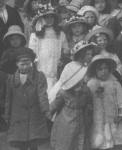 The children wearing harbinger hats in circle thirteen are wearing early forms of straw cloche hats. They are not as close fitting as the later cloches, but they testify early signs of the way. The cloche hat was non bars to the 1920s every bit is often offset thought. It was fashionable from 1908 to 1933 was 1 of the virtually farthermost forms of millinery ever, with an appearance that resembled a helmet. Cloches existed in many forms including 1 with a beret like top.
The children wearing harbinger hats in circle thirteen are wearing early forms of straw cloche hats. They are not as close fitting as the later cloches, but they testify early signs of the way. The cloche hat was non bars to the 1920s every bit is often offset thought. It was fashionable from 1908 to 1933 was 1 of the virtually farthermost forms of millinery ever, with an appearance that resembled a helmet. Cloches existed in many forms including 1 with a beret like top.
By 1911 hats became much smaller, although big broad picture hats were still worn for dressy functions. I think that in that location are too many garments with slightly puffed head sleeves for this to be as tardily as 1914. By 1914 all fullness in sleeve heads was well gone.
The Possible Appointment of the Photo.
Right -Reference Circle xiv
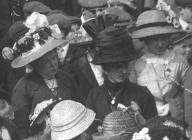 The black chapeau in circle fourteen is probably the most upwardly to date hat in the movie. In that location are dozens of hats there, but that hat speaks volumes in terms of style and only she wears a chapeau similar that. We volition date the photo by that hat and I think it is 1910. The hat she wears is an early form of the toque.
The black chapeau in circle fourteen is probably the most upwardly to date hat in the movie. In that location are dozens of hats there, but that hat speaks volumes in terms of style and only she wears a chapeau similar that. We volition date the photo by that hat and I think it is 1910. The hat she wears is an early form of the toque.
Likewise the lady in picture reference 14 wearing a pale dress/jacket side by side to her is wearing a modern garment with sleeves in the new cut where they dropped slightly down the arm. And then I will date the film at 1910. I suppose bearing in mind your comment at the time of the war there is not much betwixt 1910 and 1914, but there are substantial way changes betwixt 1912 and 1914 that eliminate those dates, now ofttimes known equally the Titanic era. This picture leans more than toward total late Edwardian styling than Titanic era styling. I'm inserting some of my hat drawing pictures. Y'all can see how the terminal pic has elements like the blackness hat in the street scene and how the others accept like features. The lady in the picture wears a lid which is combination of all these I've drawn. they volition exist bachelor with others in my next ebook. Typical Hat Styles of 1910





Male Hats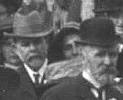
The wearing apparel, beards and hats of the men is similar in way to that favoured by Edward VII and George V. Information technology really is a wonderful picture show of children in dress. However, the trouble with the children's wearable is that it was oftentimes handed down. In the main it's typical Edwardian era wearable for children. I think they are very smartly dressed for a crowd scene and would really like to know more about the picture.
Norman's Response to my Dating the Photograph Deduction
In response to this analysis, Norman wrote back and told me he idea information technology a great deduction. He has since told me that Hebburn is about v miles from the Northward Ocean, and stands on the southward depository financial institution of the river Tyne 6 miles from Newcastle upon Tyne, making the people at that place 'Geordies'. The photo was taken in his hometown of Hebburn and is on carte du jour the same thickness of a Postcard. The folk on the Old Hebburn photograph above were Parishioners from the 'Argyle St Wesleyan Chapel' in Hebburn. Norman was told it was perhaps an outing on Easter Sunday.
 He doesn't know anymore than that fifty-fifty though he has tried hard to find out more than information. I did notice that one of the women in the photo center has a option of small badges on her glaze lapels, typical symbols worn by members of church based organizations such every bit Band of Hope Temperance Social club, or the Female parent's Marriage sections.
He doesn't know anymore than that fifty-fifty though he has tried hard to find out more than information. I did notice that one of the women in the photo center has a option of small badges on her glaze lapels, typical symbols worn by members of church based organizations such every bit Band of Hope Temperance Social club, or the Female parent's Marriage sections.
A closer look at the photograph also reveals that standing at the far left hand side is a man ina clerical collar, possibly the Church Government minister. Clerical Effigy shown correct.
Sir Humphrey Davey
In the late 1700's Hebburn was just a clutter of miners houses round the iii Collieries, 'A'Pit' 'B'Pit and 'C' Pit. Sir Humphrey Davey who invented the miners Condom Lamp went to Hebburn in 1816 and with gas from the 'B' pit he tested his lamp. All three pits were closed by the early 1900's.
Ship Building Yard in Hebburn
A Scottish man chosen Andrew Leslie fix a Send edifice thou in Hebburn in 1853 and the most famous ship was WW2 warship HMS Kelly which was portrayed in the film 'In Which We Serve' . The Kelly's Commander was Lord Louis Mountbatten and every Armistice mean solar day he came to Hebburn to have role in the march up to the Kelly grave in our cemetery. (Lots of Kelly men are buried in a mass grave after it was torpedoed in the North ocean).
Other Industries in Hebburn
Many Irish and Scottish folk flooded into the town looking for work. Before that there were Can Miners from Cornwall going there for work. And so Hebburn people can trace family unit trees back to Cornwall, Wales, Ireland or Scotland. Some Welsh teachers went at that place to piece of work in the Schools, so the Geordies really are a mixture. Hebburn also had Chemical Works, Copper works, Lead Works, Coke Works, Transport repairs with large Dry out Docking, Large Electrical Companies, etc. In the photo the building on the right with all the windows is still in that location today. It was called 'The County Hotel' in those days and probably where Mountbatten stayed on his visits. Only backside it is St Aloysius Church building. It and the Priests business firm in front of it were extended after WW1 and so are still there, but looking dissimilar. No 1 can call up the properties to the left with fence leading upwardly to it, but an Aluminium manufacturer had that land then (The Bauxite Company). You can visit Norman's site showing hundreds of old photographs of the region and its people here at world wide web.norman.dunn247.comIf yous have old pictures of the Tyneside area and the people please consider donating them to Norman'southward site. If anyone reading this knows more about the picture analysed here please write to me or Norman For those interested in more than about Hebburn, Norman has suggested they check out the site he uses chosen www.hebburn.org and suggests then going on the Hebburn Forum to ask questions, reply peoples queries and talk nearly the by in that area. One matter I do know is that as I examined this photograph I felt a connection to existent people behaving in much the same style we might whilst waiting for an result that happened near 100 years ago. I felt I would have liked to take known the lady with the about fashionable blackness chapeau. I just know nosotros would have had much to chat about. I am sure she shopped until she dropped too. I wonder if anyone of the people in this erstwhile photograph could have envisaged that they each would be studied with such interest so far alee in time. Wouldn't information technology be wonderful if ane of those modest children were alive today and able to tell us most that special day trip they had. About United states of america
0 Response to "How to Date Photographs by Fashion"
Post a Comment